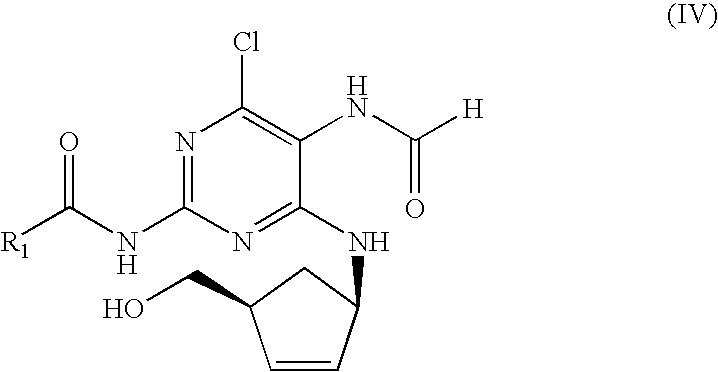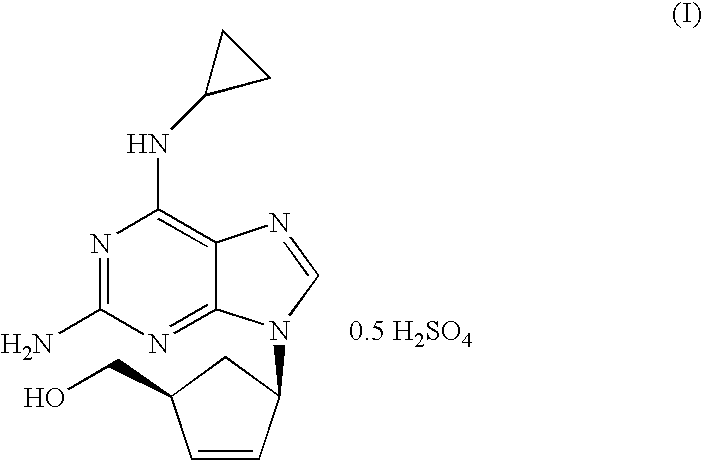Process for the preparation of abacavir
a technology of abacavir and abacavir, which is applied in the field of process for the preparation of abacavir, can solve the problems of unfavorable starting material conformation, affecting the yield and purity of the compound obtained, etc., and achieves the effect of short reaction time and low formation of impurities
- Summary
- Abstract
- Description
- Claims
- Application Information
AI Technical Summary
Benefits of technology
Problems solved by technology
Method used
Image
Examples
example 1
Preparation of (−)-N-{6-(cyclopropylamino)-9-[(1R,4S)-4-(hydroxymethyl)cyclopent-2-enyl]-9H-purin-2-yl}isobutyramide Using an isopropanolic Solution of HCl
[0037]Under nitrogen atmosphere, N-{4-chloro-5-formamido-6-[(1R,4S)-4-(hydroxymethyl)cyclopent-2-enylamino]pyrimidin-2-yl}isobutyramide (20.0 g, 56.53 mmol) was dissolved in an anhydrous solution of HCl / isopropanol 2M (170 ml, 339.17 mmol). The mixture was heated at 40-42° C. for 2 h. The resulting solution was cooled to 8-10° C., then triethyl orthoformate (28.2 ml, 169.59 mmol) was added and the reaction mixture was stirred at the same temperature for 2 h. NaHCO3 (28.50 g, 339.17 mmol) was added slowly, stirred 30 min and the salts were filtered off. To the resulting clear solution, NaHCO3 (4.75 g, 56.53 mmol) and cyclopropylamine (19.6 ml, 282.65 mmol) were added, the mixture was refluxed for 1 h and the salts were filtered off. The solution was evaporated and the syrup was dissolved in hot isopropanol (200 ml). This mixture wa...
example 2
Preparation of (−)-N-[6-(cyclopropylamino)-9-[(1R,4S)-4-(hydroxymethyl)cyclopent-2-enyl]-9H-purin-2-yl]isobutyramide
[0038]Under nitrogen atmosphere, N-{4-chloro-5-formamido-6-[(1R,4S)-4-(hydroxymethyl)cyclopent-2-enylamino]pyrimidin-2-yl}isobutyramide (15 mg, 42.4 mmol) was dissolved in an anhydrous solution of isopropanol / HCl 1 N (254 ml, 254.4 mmol) and heated to 40-42° C. for 3.5 h. The solution was cooled to 5 / 10° C. and triethyl orthoformate (21 ml, 127.2 mmol) was added. The resulting mixture was stirred for 2 h at 5-10° C. NaHCO3 (21.37 g, 254.4 mmol) was added slowly, stirred 30 min and the salts were filtered off. To the resulting clear solution, NaHCO3 (3.56 g, 42.4 mmol) and cyclopropylamine (14.7 ml, 212 mmol) were added, the mixture was refluxed for 1 h and the salts were filtered off. The solution was evaporated and the syrup was dissolved in hot isopropanol (120 ml). This mixture was cooled to 0-2° C. and the resulting slurry filtered off. The solid was dried under va...
example 3
Preparation of Abacavir Hemisulfate
[0039]N-{6-(cyclopropylamino)-9-[(1R,4S)-4-(hydroxymethyl)cyclopent-2-enyl]-9H-purin-2-yl}isobutyramide (6.56 g, 18.40 mmol) was slurried in a mixture of isopropanol (32.8 ml) and 10% solution of NaOH (36.1 ml, 92.0 mmol). The mixture was refluxed for 1 h. The resulting solution was cooled to 20-25° C. and tert-butyl methyl ether (32.8 ml) was added. The layers were separated and H2SO4 96% (0.61 ml, 11.03 mmol) was added dropwise to the organic layer. This mixture was cooled to 0-5° C. and the resulting slurry filtered off. The solid was dried under vacuum at 40° C. Abacavir hemisulfate (5.98 g, 97%) was obtained as a white powder.
PUM
| Property | Measurement | Unit |
|---|---|---|
| temperature | aaaaa | aaaaa |
| temperature | aaaaa | aaaaa |
| temperature | aaaaa | aaaaa |
Abstract
Description
Claims
Application Information
 Login to View More
Login to View More - R&D
- Intellectual Property
- Life Sciences
- Materials
- Tech Scout
- Unparalleled Data Quality
- Higher Quality Content
- 60% Fewer Hallucinations
Browse by: Latest US Patents, China's latest patents, Technical Efficacy Thesaurus, Application Domain, Technology Topic, Popular Technical Reports.
© 2025 PatSnap. All rights reserved.Legal|Privacy policy|Modern Slavery Act Transparency Statement|Sitemap|About US| Contact US: help@patsnap.com



